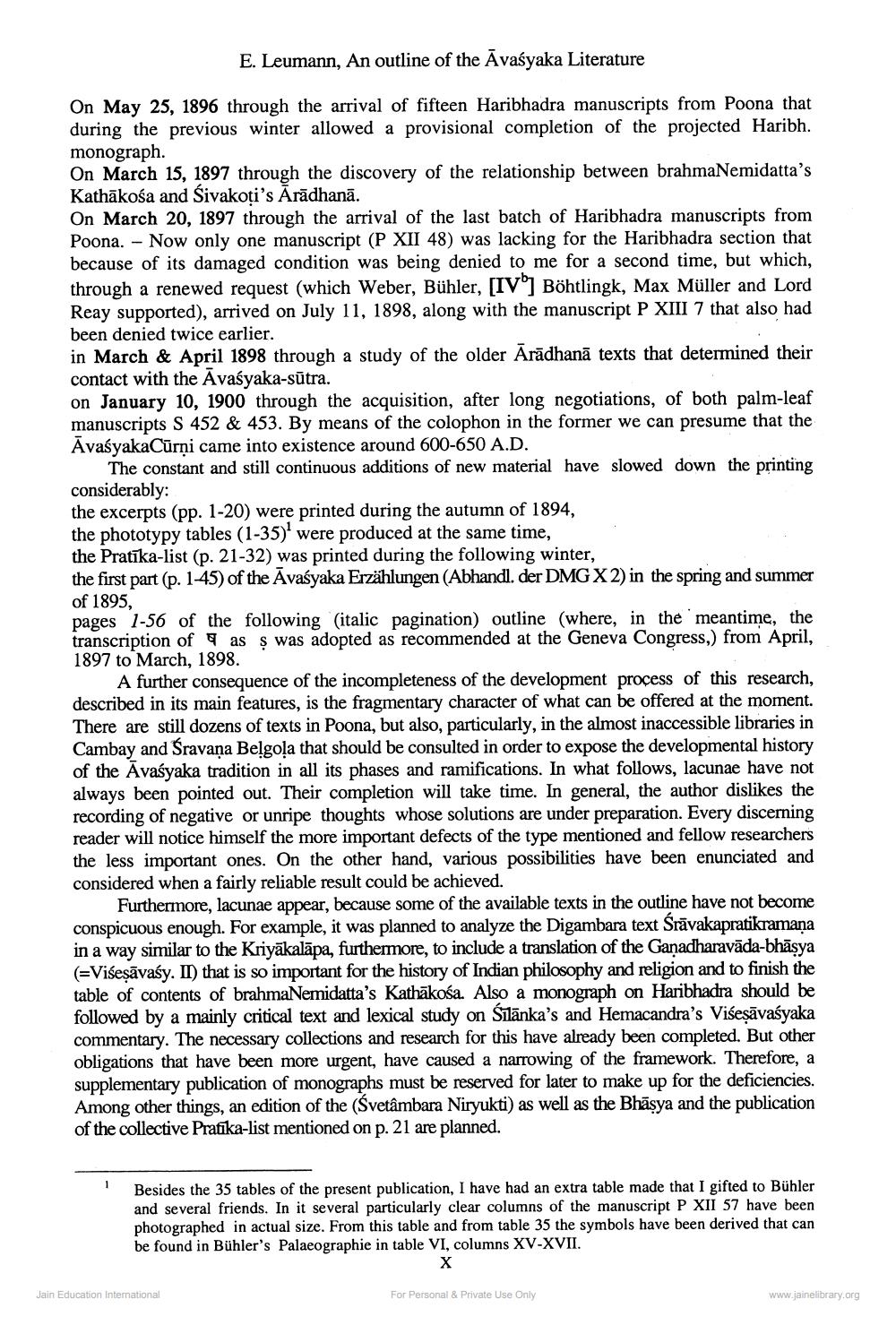________________
E. Leumann, An outline of the Avasyaka Literature
On May 25, 1896 through the arrival of fifteen Haribhadra manuscripts from Poona that during the previous winter allowed a provisional completion of the projected Haribh. monograph.
On March 15, 1897 through the discovery of the relationship between brahmaNemidatta's Kathakośa and Sivakoti's Aradhanā.
On March 20, 1897 through the arrival of the last batch of Haribhadra manuscripts from Poona. Now only one manuscript (P XII 48) was lacking for the Haribhadra section that because of its damaged condition was being denied to me for a second time, but which, through a renewed request (which Weber, Bühler, [IV] Böhtlingk, Max Müller and Lord Reay supported), arrived on July 11, 1898, along with the manuscript P XIII 7 that also had been denied twice earlier.
in March & April 1898 through a study of the older Aradhana texts that determined their contact with the Avaśyaka-sūtra.
on January 10, 1900 through the acquisition, after long negotiations, of both palm-leaf manuscripts S 452 & 453. By means of the colophon in the former we can presume that the AvasyakaCūrṇi came into existence around 600-650 A.D.
The constant and still continuous additions of new material have slowed down the printing considerably:
the excerpts (pp. 1-20) were printed during the autumn of 1894,
the phototypy tables (1-35)1 were produced at the same time,
the Pratīka-list (p. 21-32) was printed during the following winter,
the first part (p. 1-45) of the Avasyaka Erzählungen (Abhandl. der DMG X 2) in the spring and summer of 1895,
pages 1-56 of the following (italic pagination) outline (where, in the meantime, the transcription of ass was adopted as recommended at the Geneva Congress,) from April, 1897 to March, 1898.
A further consequence of the incompleteness of the development process of this research, described in its main features, is the fragmentary character of what can be offered at the moment. There are still dozens of texts in Poona, but also, particularly, in the almost inaccessible libraries in Cambay and Śravana Belgola that should be consulted in order to expose the developmental history of the Avasyaka tradition in all its phases and ramifications. In what follows, lacunae have not always been pointed out. Their completion will take time. In general, the author dislikes the recording of negative or unripe thoughts whose solutions are under preparation. Every discerning reader will notice himself the more important defects of the type mentioned and fellow researchers the less important ones. On the other hand, various possibilities have been enunciated and considered when a fairly reliable result could be achieved.
Furthermore, lacunae appear, because some of the available texts in the outline have not become conspicuous enough. For example, it was planned to analyze the Digambara text Śrāvakapratikramaṇa in a way similar to the Kriyakalapa, furthermore, to include a translation of the Gaṇadharavada-bhāṣya (=Viseṣāvaśy. II) that is so important for the history of Indian philosophy and religion and to finish the table of contents of brahmaNemidatta's Kathakośa. Also a monograph on Haribhadra should be followed by a mainly critical text and lexical study on Silanka's and Hemacandra's Viseṣāvasyaka commentary. The necessary collections and research for this have already been completed. But other obligations that have been more urgent, have caused a narrowing of the framework. Therefore, a supplementary publication of monographs must be reserved for later to make up for the deficiencies. Among other things, an edition of the (Svetâmbara Niryukti) as well as the Bhāṣya and the publication of the collective Pratika-list mentioned on p. 21 are planned.
1
Besides the 35 tables of the present publication, I have had an extra table made that I gifted to Bühler and several friends. In it several particularly clear columns of the manuscript P XII 57 have been photographed in actual size. From this table and from table 35 the symbols have been derived that can be found in Bühler's Palaeographie in table VI, columns XV-XVII.
X
Jain Education International
For Personal & Private Use Only
www.jainelibrary.org




